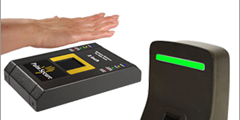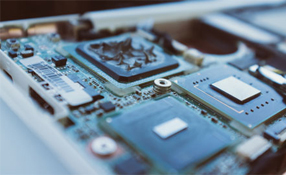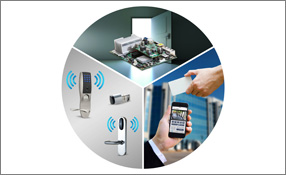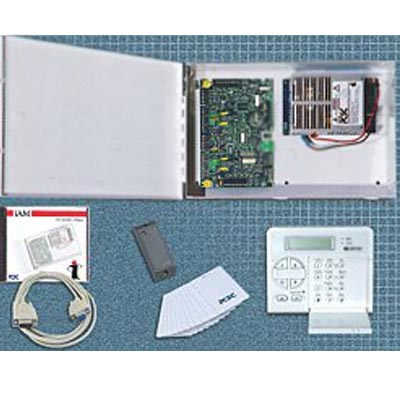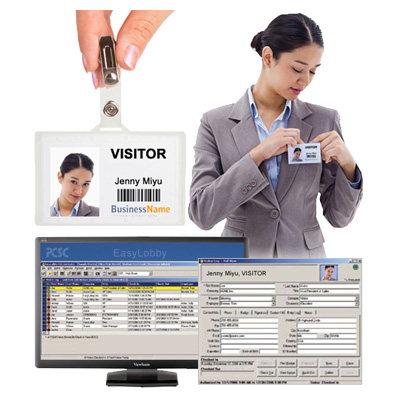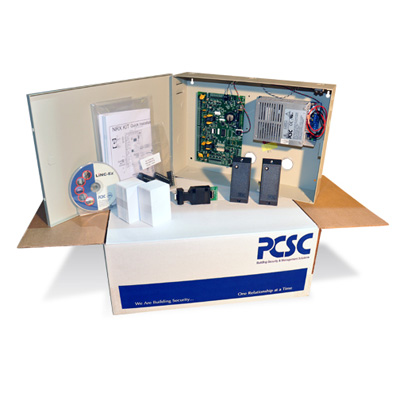PCSC - Experts & Thought Leaders
Latest PCSC news & announcements
PCSC, a designer and manufacturer of access control solutions and Coolfire Solutions, a St. Louis based software company known for creating Military-Grade situational awareness platforms, collaborate to deliver top-level capabilities for access and security. Coolfire Solutions created its innovative Ronin Platform to deliver software that sits on top of existing systems and infrastructure to transform data into actionable intelligence. Originally developed for the U.S. military, the Ronin Platform is being widely adopted by industry leaders and organisations who recognise the importance of placing the right data, in the right hands, in real-time, so that intelligent decisions can be made. LiNC-NXG PSIM system Stacking the Ronin Platform on top of the data provided by PCSC’s LiNC-NXG PSIM system provides a robust, real-time common operational pictureStacking the Ronin Platform on top of the data provided by PCSC’s LiNC-NXG physical security information management system provides a robust, real-time common operational picture, visually representing physical security events, and enabling a coordinated security response. For instance, urgent security related event details are pushed to mobile devices of nearby security officials for immediate action. An additional benefit, in the case of an on-premises environment, the underlying access management system is not exposed, only the top-level data is managed. Extend the capabilities of access solutions “An extremely impressive GUI for our industry and an actionable set of features extend the capabilities of PCSC’s access solutions for real-time response,” said Mas Kosaka, President and CEO of PCSC. “The expansion possibilities are virtually limitless too. We’re excited to debut the capabilities of Ronin to our Business Partners during the PCSC Symposium in conjunction with ISC West, the largest security industry trade show in the U.S.” Coolfire Solutions and PCSC have the experience and capabilities to transform the way security professionals do their job every day" “Coolfire Solutions and PCSC have the experience and capabilities to transform the way security professionals do their job every day. We can maximise the value of existing technology investments by combining data from any source and making it actionable," said Don Sharp, CEO at Coolfire Solutions. "Security professionals have an incredibly challenging job and it’s only getting tougher. By bringing all of their critical data onto a single pane of glass we can increase the level of security while driving significant operational efficiencies.”
The BioConnect Identity Platform provides an integration of Suprema's biometric solutions with the majority of leading access control systems BioConnect and Suprema have announced Suprema's launch of the BioConnect Identity Platform. Developed by BioConnect, Suprema's long-standing strategic partner in North America, the BioConnect Identity Platform provides an integration of Suprema's biometric solutions with majority of the leading access control systems in the global security market. Under the appointment, Suprema will provide and support the BioConnect Identity Platform globally from June 1st, 2016 onward. Powerful integration featuresWith the BioConnect Identity Platform's powerful integration features and BioConnect's and Suprema's partner eco-systems, enterprises benefit from the ability to take advantage of deploying biometrics with their existing (or their choice of) access control vendor, standards, devices and way of operating. The BioConnect Identity Platform enables the seamless integration of Suprema's biometric terminals with access control systems, ERP and time and attendance systems, supporting biometric and multi-factor authentication, biometric enrollments and user ID management. One central system The solution enables greater security, identity assurance and convenience from one central system and has ultimately changed the way that the physical access control market can consume biometrics as an authentication strategy. No other manufacturer around the world has been able to offer this level and quality of integrations - with the BioConnect Identity Platform boasting over 20. "With the BioConnect Identity Platform, BioConnect complements our goal of providing industry-leading biometric security solutions to the global market. The product is a ready-made bridge solution that provides easier integration of cutting-edge Suprema biometric technology together with a customer's choice of leading access control systems," said Young Moon, VP of Suprema. "We are looking forward to providing the BioConnect Identity Platform to a more global security market and are excited to offer our customers a seamless and cost-effective way of adopting Suprema's biometric security solutions," Moon added. Innovative technologies From the perspective of the access control provider, the BioConnect Identity Platform opens up the option to provide a Suprema biometric solution and continue to benefit from the complete product line as Suprema brings new and innovative technologies to market. "As a Suprema partner we have experienced a lot of growth in the North American and UK markets due to its leadership and continued emphasis on producing biometric products of superior quality, versatility and range," said Steve Greb, Strategic Director of Business Development at BioConnect. "We're very excited to draw on Suprema's impressive partner network and continue to build out our Quest for Rightful Identity on a global scale." Integration with leading systems The BioConnect Identity Platform integrates the following leading access control systems with the Suprema biometric terminals; ACT ACTManage, AMAG Symmetry, Axis A1001, Brivo OnAir/OnSite, Genetec Security Center, IMRON IS2000, Lenel OnGuard, Open Options dnaFusion, Paxton Net2, Honeywell ProWatch, Honeywell WINPAK, RS2 AccessIT!, S2 Netbox, Software House CCURE 9000, Stanley SecureNET, Gallagher Command Centre and now PCSC LiNC-PLUS. Suprema and BioConnect will team together to showcase the BioConnect Identity Platform at IFSEC 2016 in London on June 21st-23rd at Stand E1400.
Agreement enables enhanced technical support and faster time to installation for PalmEntry and PalmEntryXS solutions Fujitsu Frontech North America Inc., a leader in innovative technology and front-end solutions is pleased to announce that Torrance, California-based PCSC will be the master distributor for PalmEntryTM and PalmEntryTMXS physical access control solutions effective immediately. Both PalmEntry and PalmEntryXS are based on Fujitsu’s award winning PalmSecure® palm vein biometrics technology. Quality access control solutions PCSC is a designer and manufacturer of quality access control solutions ranging from integrated hardware to sophisticated access control management software, including door entry access, video badging, CCTV control, elevator control, alarm graphics, PoE network peripherals, and video integration. “We are delighted that Fujitsu has chosen PCSC as the master distributor for PalmEntry and PalmEntryXS solutions,” according to Mas Kosaka, President and CEO, PCSC. “This agreement will allow us to build and complement our existing product portfolio while enabling us to penetrate new markets with our security solutions.” Limits of the Fujitsu-PCSC agreement This master distributor agreement applies only to PalmEntry and PalmEntryXS solutions. Fujitsu Frontech North America Inc. will continue to be the primary supplier of PalmSecure technology that includes PalmSecure Mouse, PalmSecure for Single Sign-on and PalmLockTM for SAP. Existing PalmEntry and PalmEntryXS solution customers can expect to receive the same high level of customer service and customer care from the Fujitsu Frontech North America support team. Fujitsu’s palm vein device canonly recognise the pattern if theblood is actively flowing withinthe individual’s veins, soforgery is virtually impossible Palm vein biometric technology solutions PalmEntry and PalmEntryXS solutions are based on Fujitsu’s patented PalmSecure palm vein biometric technology. “By streamlining the sales channel, we are creating greater efficiencies that will enable PCSC to maintain and even augment the high level of customer service and care their customers receive today, while being very price competitive,” according to Randy Fox, Vice President of Sales and Marketing, Fujitsu Frontech North America Inc. “PalmEntry and PalmEntryXS solutions will be a nice addition to the robust suite of products and services offered by PCSC”. Fujitsu PalmSecure biometric palm vein sensors use a near-infrared light to capture a user’s palm vein pattern, generating a unique biometric template that is matched against the palm vein patterns of pre-registered users. Unlike other readers, the PalmSecure device does not come into contact with the skin, making it extremely hygienic, non-intrusive and unrestricted by external factors such as skin types and conditions. Registration for PalmSecure device users takes less than one minute and authentication takes less than one second. Reliable authentication Fujitsu’s family of biometric solutions, PalmSecure® sensors, PalmSecure for SSO (single sign-on) and the PalmEntryTM Physical Access Control system all utilise the award-winning technology. The palm vein device can only recognise the pattern if the blood is actively flowing within the individual’s veins, so forgery is virtually impossible. This advanced, vascular pattern recognition technology not only provides highly reliable authentication with low false accept and reject rates, but also allows for fast and easy enrolment.
Insights & Opinions from thought leaders at PCSC
Systems may be reliable and performing as originally intended, but can also beoutdated in comparison to current technology offerings Let’s start by defining what a legacy system is in the context of a security control system. Legacy refers to an installed and operating security control system made up of numerous components, both hardware and software, that have been eclipsed by newer technologies. A shortage of parts and pieces may be creeping in, and it’s also likely the older stuff has a service tech scratching his head when faced with a configuration setting or data entry protocol. The newer technologies, however, may still be providing much of the desired functionality required by the legacy system user. Legacy in this context then is not necessarily a pejorative term. The system may be both reliable and performing as originally intended but is outdated in comparison to current technology offerings both from a communications standpoint and as it relates to applications and data mining. So what to do? For openers, as my dad would day, do a Ben Franklin list of do’s and don’ts. Naturally you’d love to move to a new, bigger or smaller, better and faster system. But, first, what does that list look like? I for one think is might begin to look like this: Things to do when managing legacy systems Do you have a handle on your current technology capabilities? Many legacy systems are underutilised and have features that are not used. Revisit your systems capabilities: You are likely to make some pleasant discoveries. Do you have a handle on your current technology capabilities? Many legacy systems are underutilised and have features that are not used Do you currently know how all of the pieces and parts in your system are currently communicating? A great start for planning the next steps is to understand the “plumbing.” Associated with that is the location of communication; specifically, how are things wired and where are they terminated, recorded and catalogued? What does your power distribution for the system components look like? Do you have backup and other means of maintaining operations during a loss of power, and where is that stuff? If not done recently, this step provides an opportunity to ensure you are ready for things that don’t happen and also to revisit codes. It’s always worthwhile if a maintenance provider is available to a system test in this area, or it can be self-conducted. What is the state of your record management, and when was the last time you did some basic housekeeping, such as backup and the like? If you don’t remember when you did it last, stop reading and go do some housekeeping — it’s clearly due now! What works for you and your organisation, and what have you developed a work-around for? If your “super users” have found ways to manage desired system outcomes by some clever workaround, are there other desired features? Do you have a relationship with an authorised service provider or an on-staff trained first responder? Do you have attic stock (stuff you own) to support those older components? I like to think of it like making a road trip with a spare tire and basics in the trunk in case an extended unplanned stop on the side of the road interrupts your trip. Have you developed a plan for an eventual upgrade? What’s first, what does it cost and whom will I let provide pricing to do so? Rip-and-replace isn't your only option. There are many products and servicesavailable to migrate from a legacy to next steps utilising embedded infrastructure Planning and management What are my/your basic functional requirements, and where are the gaps now you must fill for enterprise sustainability? That legacy system likely has paid its way and now needs to be retired; I’m not ready either. Do you have a business case for this refresh – applications, data mining, new and reporting and risk mitigation strategies? If not, you are missing this first step of legacy migration planning and management. Managing the age includes a system exit strategy. Getting C suite, namely your CFO’s, attention is key; sustainability of your enterprise is 101, so functionality as it relates to risk mitigation is essential to keeping your entity flourishing. So what are the DON’T’s? Don’t trivialise the migration or response to the Do’s or you’ll end up in a big To Do. Don’t minimise the relationship with existing integration resources you have worked with, old and new. Organisations evolve, some for the best, some not so. Refresh these relationships as well; resources are like bridges – you never know when a crossing is needed. Don’t rush into the latest and greatest; be wary of who’s definition you subscribe to. There’s a reason they call it the “cutting” edge. Don’t believe that rip-and-replace is your only option. There are many legacy systems in our industry, and many well-made and well-thought-out products and services are available to migrate from a legacy to next steps utilising embedded infrastructure. The bottom line: Define your parameters, select your partners and engage companies with a history of legacy migration and thought leadership. If your legacy includes some products with forward-thinking engineering thought leadership, you may be able to manage your needs with security control board-level replacements or the flashing of new firmware and upgrades to software. I‘m aware of several companies whose products elegantly move through time, adding new applications and functionality without wholesale rip-and-replace. These legacies carry on. The market has responded to you and others eager to know their options. There are many ingenious and clever ways to upgrade communications and transport of data, reliable mainstream products designed to meet this challenge head-on. There are solutions aimed at allowing you to use current IT and Internet of Things (IoT) apps and functionality. However, there are also quite a number of technology partners able help make the leap from analogue to digital using existing pathways. The bottom line: Define your parameters, select your partners and engage companies with a history of legacy migration and thought leadership. They are most likely to produce the best results and allow you to leave behind the legacy you want to be associated with.
Overwhelmed by too many choices for an access control system? Where do you start? Always seeking to help, SourceSecurity.com asked access control suppliers to describe what differentiating characteristics set their systems apart from others in the market. AMAG: Easy migration, simple pricing model AMAG’s Symmetry platform includes access control, photo ID badging, visitor management and digital video server software, all standard in an integrated solution. The pricing model is easy – up to 512 readers can be added to the software platform; most options are covered with the base charge. The platform is cost-effective, even for small systems. The Symmetry Retrofit program provides easy migration (without a screwdriver) from legacy or end-of-life products such as Casi/GE systems. Options include the Threat Level Manager, which can customise system settings based on a selected level of threat. Symmetry is also compatible with G4S’ One Facility workflow management system, and Symmetry Web thin client application enables use of mobile devices. AMAG’s new true two-door PoE controller includes two reader ports, two lock relays, two REQs and two door status inputs. AMAG has a long list of third-party integrations. Brivo Systems: A truly cloud-based system Brivo Systems provides access control in a truly cloud-based system in a software as a service (SaaS), recurring revenue model. All firmware and software systems are updated automatically. The cloud service works with Brivo’s IP door controllers. End users only pay for what they use. Continental Access: From one door to ten thousand CardAccess 3000 software by Continental Access is easy to use and yet enterprise class – able to control access to one door or to ten thousands of doors in locations worldwide. Designed by Continental Access in the United States, the robust hardware continues a legacy of the company founded in 1961. Total cost of ownership is low; Continental Access does not charge mandatory end user support fees to integrators. Additionally, CardAccess 3000 is integrated with video management systems and other systems such as visitor management, time and attendance, gated community software and several sister companies’ products – Napco intrusion products and Alarm Lock wireless Networx and ArchiTech Locks (with Marks locking hardware). Web-delivered user interface benefits end users and integrators in terms of lower total cost of ownership as well as ease of operability Frontier Security’s deep integration with video Frontier Security’s access control system features deep integration with video, providing a more efficient and powerful process to correlate access events and transactions with corresponding video. Another capability is advanced alarm filtering and routing to provide alarms to the appropriate parties. Frontier also provides powerful capabilities to filter and view card transactions. The new HTML5 web interface provides an easy way to access common functionalities from browsers and tablets. Galaxy Control Systems: Easy to upsell Galaxy Control Systems' System Galaxy software solution is not “brand”-dependent and is easily implemented in existing systems to enhance functionality. Improvements in performance and efficiency available with new and evolving access control technologies are even more valuable to integrators and end users when they are interoperable with earlier generations of systems. System Galaxy enables systems integrators to cost-effectively upsell business. The backwards-compatible software enables future business development with new customers who have old systems. The advanced architecture also allows dealers and integrators to offer access control as a managed service. Multi-client functionality can manage and control several systems on a single backbone, much like the approach found in facilities that have multiple tenants. Genetec’s unified Security Center The Genetec access control system, Synergis, is built into to the company’s unified Security Center platform, which brings together IP video surveillance and access control into one easy-to-use solution. Common security operations from multiple systems are standardised, including monitoring, reporting, alarm management and configuration. Within a single intuitive client application, operators can see corresponding video each time a cardholder touches their card to a reader. The cardholder information is displayed automatically. In case of an access-denied alarm, operators can quickly address the situation by confirming the cardholder’s identity and assigned access rights. Decision-making and investigations are faster because operators don’t have to navigate among different applications to understand what took place. Redundancy is achieved at the controller level, not simply from a redundant network server Honeywell: A choice for anybody Honeywell offers two access control systems – the ProWatch geared toward enterprise customers and the self-contained WinPak for entry-level to mid-market applications. Sold through dealer/integrators, ProWatch implementations are customised for each customer and include the Honeywell SDK to ensure integration with a wide range of existing equipment. Customers include enterprise, Fortune 500, and multi-city and countrywide applications, including multiple points of control. There is no limit to the number of doors and card-holders – one centre manages 10,000 doors. WinPak comes in three “flavours” – the XE entry level for 1 to 16 doors, the mid-range SE for 16 to 32 doors, and the PE (professional edition) geared toward multiple locations, including field offices or satellites. WinPak has dozens of native integrations. PCSC’s Fault Tolerant Controller PCSC’s flagship access control product, the Fault Tolerant access controller, uses a patented process for automated system recovery. If a primary controller should fail, an alternative controller automatically takes over the duties of the failed controller. Redundancy is achieved at the controller level, not simply from a redundant network server. The Fault Tolerant Controller also uses a Hydra Protocol to use peer-to-peer communication to keep the system updated. Ethernet and PoE are standard, and optional wireless mesh communication is also available. For integrators, the system provides better reliability with fewer problems both from a system network and physical security point of view. Result: Lower installation and operating expenses and better performance and security. S2 Security features web-delivered interface S2 Security access control products use a web-delivered user interface. Customers can access their systems without requiring an installed client, whether in a fixed or mobile environment. Credential-based access control, intrusion detection and video applications are integrated seamlessly for a unified management and administration experience. The web-delivered user interface benefits end users and integrators in terms of lower total cost of ownership as well as ease of operability. No software installation or client license fees are required. The system can be accessed from any authorized computer, and key access control functions are also available on mobile devices using S2 Mobile Security Officer. Security is more unified because both physical and logical security apps can share a common database Tyco Security provides plenty of options Software House’s C-Cure 9000 combines its iSTAR Door Controller with enterprise-level access control features. A scalable, fully distributed and robust architecture – empowered by iSTAR controllers – can meet complex regional, global and enterprise access control challenges. Kantech access control solutions from Tyco Security Products offers low installation cost and ease of use. Minimising installation time and need for product knowledge decreases total cost of ownership, both related to software and hardware-based solutions. CEM Systems’ AC2000 access control system differentiates itself by its IP Edge devices, such as the Emerald reader, a terminal at the door that has the ability to run applications like a smart phone or tablet. This capability allows customers to post announcements on the keypad or even add a checklist to access control decisions for things like health and safety or hazardous areas. Viscount Systems emphasises IT Eliminating proprietary panels altogether, the software and databases of Viscount Systems’ Freedom access control system are hosted on physical or virtual servers. Multiple synchronised servers provide higher security, built-in resiliency and the ability for IT departments to leverage existing infrastructure. With the Freedom solution, integrators and end users can utilise native IT software that resides on a non-proprietary server and is deployed virtually across multiple servers or in the cloud. Updates are done in real-time and under the control of the customer. Leveraging existing IT infrastructure and resources also makes the Freedom solution cost-efficient and scalable. Security is more unified because both physical and logical security apps can share a common database.
More attention needs to be placed on the development of readers that can accommodate Wireless and Wi-Fi technology Many of the changes in the access control market are happening at the “edge” – at the reader level. Access control advances that continue to become more widespread include wireless and PoE-enabled access control hardware such as wireless locks and PoE door controllers, which both reduce installation costs. Other trends are related to mobility; one is the increased use of smart phones and tablets for day-to-day access control operations. Another is the increased adoption of mobile credentials – leveraging near field communications (NFC) or Bluetooth Low Energy (LE)-enabled technologies that allow smart phones to be used as access control credentials to enter a building instead of traditional credentials such as cards. Emerging technology platforms can fragment and hinder the market, among both integrators and end users. Do we install and use Bluetooth, NFC or the latest in biometrics? Are they safe, proven, and are there standards? “Only time will prove which technologies are better,” says Greg Hetrick, PCSC’s director of marketing. “Until then, it’s anyone’s guess, often at the expense of real-world scenarios. By the time it’s proven, new technologies become available. The cycle is always turning.” The best approach is to find the right balance between today’s and tomorrow’s technologies, he adds. Wireless and Wi-Fi technology is inching into the access control space, and because of this, more attention needs to be placed on the development of readers that can accommodate this technology. Accompanying issues include the level of integration with traditional physical access control systems and safety concerns when recommending and deploying these devices, says Robert Laughlin, president of Galaxy Control Systems. John L. Moss, CEO of S2 Security, sees access control evolving in the next five years in relation to “bring your own device (BYOD),” global distributed systems in the cloud, and inexpensive wireless locksets. “With the ubiquity of smart phones and BYOD, people will use mobile devices as personal credentials, either with Bluetooth LE or by using an app built into the device,” he says. “New business models will evolve around these new technologies that will benefit end users through reduced total cost of ownership and integrators through a shorter replacement cycle, which is typically long in access control,” Moss comments. Hetrick believes that in the near future, smart phones or wearables will become the primary source for card access, door entry, system access, payments, health information and identification In the near future, access credentials will become more mobile and more portable, whether physical or cloud-based. “Your smart phone or wearable (smart watch) will become your primary source for card access, for door entry, system access, payments, health information and identification,” Hetrick says. Virtual credentials may live in the cloud versus on a device. If someone switches to a new employer, for example, no new credentials will be assigned. Rather, they are simply authorised and activated by the new employer and deactivated by the previous one. When it’s time to upgrade a device, the credentials are available via the cloud to the new device, Hetrick says. “Device security will improve via biometrics (fingerprint, i.e., Touch ID; and perhaps facial recognition using a device’s camera) with multiple forms of authentication and rolling encryption,” Hetrick says. “As a manufacturer, we hear about biometrics, NFC, these are all things we see, but it’s hard to integrate them into our platform,” says John Smith, senior channel marketing manager, Honeywell Security. “There are 100 different biometrics, not operating to a standard. Most of our systems can work with these things, most have a Wiegand or standard output, but the enrollment piece might be a problem and require a separate application. We as a manufacturer are watching it closely, but we haven’t seen it as a big draw.” For example, a predominant leader hasn’t emerged relative to NFC. Also, biometric readers are three to 10 times more expensive than a card reader, so cost justification has to come down, he adds. Jason Ouellette, product line director, access control, Tyco Security, suggests the future of access control will be a matter of “back to the future.” He expects more access control systems will be based on a cloud environment, reminiscent of the days of mainframe computers. The edge devices that provide the monitoring, reporting and day-to-day management of access control will be comparable to yesterday’s “dumb” terminals. “Additionally, we will see a shift from the traditional plastic cards and fobs to electronic credentials managed through smart devices like mobile phones and tablets,” he adds. “One more shift will be the use of biometrics, such as facial recognition, for access control, which will create a ‘frictionless’ mode of access control as the technology improves,” Ouellette says. “While the technology of cloud-based servers over mainframes and tablets or mobile phones provides far greater capabilities, it will also drastically change the way access control is installed, managed and encountered by end users over the next five years.” More access control systems will be based on a cloud environment, reminiscent of the days of mainframe computers. The edge devices that provide the monitoring, reporting and day-to-day management of access control will be comparable to yesterday’s “dumb” terminals Richard Goldsobel, vice president, Continental Access, sees some movement to more secure (than Wiegand) RS-485 readers. However, he says the the hype for access control right now revolves around moving the access credential to smart phones, using either NFC or Bluetooth LE technology to communicate with the reader. Problem is, the technologies are battling, and both have their pros and cons, but the functionality will be similar. The convenience of the credential on the phone, of course, is the major driving factor, but the functionality also raises some new security concerns. Security may dictate that additional functions be running on the smart phone app, such as biometrics or PIN processing. However, a need for additional actions to be performed on the phone will reduce convenience, says Goldsobel. “Your smart device will continue to play a larger role in the systems,” agrees Greg Love, vice president of sales, AMAG. “You can manage the system and get into the area, all with the same device.” He also sees additional options ahead for hosted, Web or embedded solutions – all from one manufacturer. “The customer can make the choice of how they would like to manage their security,” he says. New solutions will extend above and beyond access control and video management – including risk management, emergency preparedness and enhanced reporting outside of security responsibility. “It’s more of a total facility management system that takes advantage of the network in its entirety,” says Love. New technologies also bring new risks. Hetrick says the market should consider carefully issues related to credential and identity security, whether lost, stolen, duplicated or authenticated. “Can an access point identify that the access device authenticates the actual physical identify of the user?” he asks. “Is a lost card or hacked and stolen mobile device with NFC access able to open a secure door? Or is the access point also smart, i.e., able to use facial recognition to confirm that the card or device and the user are indeed one and the same, and therefore authorized? Or is this just a duplicate access device or card being used by a criminal? Can a duress situation be discreetly announced and identified, perhaps granting access while simultaneously notifying authorities? Will virtual and cloud-based credentials be at risk for attack, theft or duplication? Technology opens new layers of security risks. Are these risks masked, unforeseen? What preventions can be enabled?” Smith of Honeywell says the traditionally slow-moving access control market is being forced to embrace new and changing technologies, and many installers are not comfortable with the situation. It takes a lot for a dealer to change its products or business model. Some are resistant to change, and others have a hard time finding qualified talent to deal with new technologies. “We are lagging behind technology as a whole,” says Smith. “A lot of dealers we have are resistant, it doesn’t fit their current business model, and they will have to change.”
Using artificial intelligence (AI) to automate physical security systems
DownloadA modern guide to data loss prevention
Download7 proven solutions for law enforcement key control and asset management
DownloadThe truth behind 9 mobile access myths
DownloadAccess control system planning phase 2
Download




